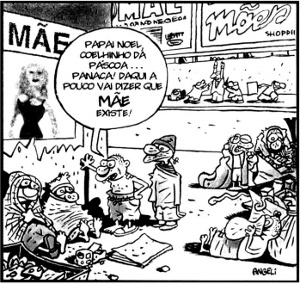Those who know about the computer world are aware of all the technological innovations. The curious thing is to see how these innovations interfere in communicative situations, generating a lot of material for linguists. We already know that the internet has brought about a radical change in reading and writing processes, creating new “virtual dialects” that often subvert the semantics and, in the most serious cases, even trample the syntax.
With the advent of the internet, new words were added to our vocabulary, especially words of English origin. The word delete, for example, stopped being a linguistic fad and gained an entry just for it in Portuguese language dictionaries: delete it means erasing, and today pretty much everyone knows it. In addition to lexical contributions, the internet also brought about the popularization of some symbols that were previously mere unknowns. The @ (at sign), which serves to indicate the location of e-mail addresses - emails –, before it was just a mercantile symbol used to replace the English word
at. The # (hash or “game of old”), found on landlines and cell phones, had the function of activating additional features in these devices, such as extra services offered by operators. Surely you've seen this symbol - # - and you probably know it by another name... We don't even need to present, you already know the hashtag. But do you know how to use it?To answer this question, let's investigate the origin of hashtag in computing. Who proposed the use of hashtag to add a particular topic to a discussion group was IRC, Internet Relay Chat, a kind of communication protocol used in chats and file exchange. Its main function, when it began to be used in web, was to index a topic or subject on social media. In this way, all users could have access to a particular discussion, since, when clicking on a hashtag + word (channel name), it was transformed into a hyperlink (linking a text to other documents, resulting in a hypertext).
Absolutely useful, don't you think? If you want to stay on top of the current discussion and see what other users on the network are sharing, just click on hashtag and find out about it. It turns out that we are linguistically versatile and we were soon finding another function for the hashtags... To give a post a mood effect, whether it's shared on Facebook, Instagram or Twitter, we've filled our posts with hashtags that are of no use at all, since that subject is unlikely to become a reason for debate or controversy on the network. You don't even think your hashtag#partiuacademia or #birthdaydapaty will end up on the list of the most talked about topics of the day, won't it?
Do not stop now... There's more after the advertising ;)

Initially, the hashtags were used with the channel name to index a topic in a particular internet discussion group
When used in this way, inadvertently, the hashtags can cause a real disturbance to the understanding of the message. This is because all accents and punctuation are dispensed with, under the justification of giving dynamism to the writing, since in the Internet communication happens very quickly. This exaggerated use of hashtags it is part of the discussion about the importance of the standard language in electronic media. Grammatical rules are often neglected, and unfortunately this carelessness with the language can interfere in the writing of texts that require adaptation to the formal language. Say that #needs respecting linguistic variations (It is necessary to respect the linguistic variations), thus, making it difficult to read and understand the text.
What we are trying to say is that, the linguistic variations they are important and must be respected, as they are part of the cultural identity of a people. What is not ideal is to allow the computer language to make it difficult to understand a message, since the purpose of every speech act is communication. If the recipient doesn't understand the message, communication is impaired, and that's exactly what happens when you overuse the hashtag. It is necessary to take into account the principle of linguistic adequacy, that is, it is desirable that you understand that each situation requires a specific type of language, as it makes no sense to fill your Portuguese language assessment in hashtags, just as it doesn't make sense to write in a flowery way in a harmless internet chat.
The exaggerated use of hashtags in virtual environments it spreads confusing and disconnected messages, as they are not supported by the grammar rules that would facilitate their understanding. At this time, common sense should speak louder: leave it to use the hashtags just to publicize or participate in a discussion on the Internet. Knowing how to use language in different communication situations is a virtue of those who are polyglot in their language itself, of the speaker who knows that each linguistic situation requires a specific type of language. hashtags too much hinder written communication, and what is writing for if not as a powerful instrument for the reader to understand? Think about it!
By Luana Castro
Graduated in Letters



